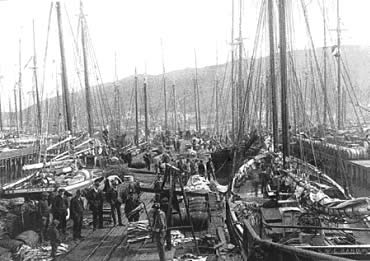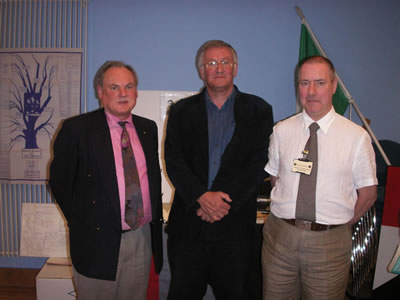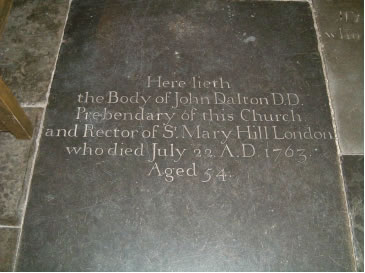|
From Millicent Craig
The following account of Exploits Bay and the life
of her boat builder Dalton ancestors is the contribution of DGS member,
Carol Jefferies of Stitsville, Ontario, Canada. For those with ancestry
in Newfoundland, the locales may be familiar to you. For those seeking
more information on Daltons in this area, the file for Canada in the Dalton
Data Bank contains a huge compilation of Newfoundland Dalton data including
place names mentioned in the Diary of the Minister.
Dalton Boat Builders
It is the spring of 1833, before the ice has melted from
the salt waters on Notre Dame Bay and probably the best and easiest time
to travel this harsh remote place. If you look at the map of Newfoundland,
on the east coast of Canada, you will notice it is loosely in the shape
of an L. In the inside bend of that elbow is Notre Dame Bay which leads
into The Exploit's River. In the time period there was much lumbering
going on. The trees were tall and straight and our branch of the Dalton
family made good use of these timbers by building them into tall masted
fishing and seal hunting boats known as schooners.
 |
The Dock at Exploits Harbor |
The schooners were made to withstand the rigors of the
North Atlantic and below are a few of the boats that were built by my
ancestors. Judging by the re-use of a schooner name, one can deduce that
not all schooners returned to the harbor.
Builder, name of schooner and date of construction:
Charles Dalton:
Isabella 1844; Perseverance 1832; Revenge 1838; Trial 1848
Eugene Dalton:
Sir John Glover, 1879
G. Dalton:
Sally, 1826
Garret/Garrett Dalton:
Fanny,1831; Brazilian Patriot, 1836; Fanny, 1882
John Dalton:
Annie D. 1882; Clara Jane, 1880; Kate, 1871; Lady Glover,
1877; Ripple, 1878; William Paterson, 1879
Mathew/Matthew Dalton:
Native Lass, 1848; Native Lass1863; United Brothers,
1841; Hephzibah, 1884
Philip Dalton:
Thomas Albert, 1880
Thomas Dalton:
Marie Malvina, 1885
From the Diary of a Travelling Minister
An itinerant minister decided that he would take a trip
from Twillingate which is at the mouth of the Notre Dame Bay around to
the various small villages. He kept a diary of his trip which was published
in several parts in the Twillingate Sun in 1883. It tells of life in the
area and some of its occupants including those of Matthew Dalton senior
(my husband's great great grandfather) and his sons and some of our extended
family. The minister, only identified as J. P., submitted 10 diary excerpts
to The Sun. Parts 1 -5 are printed in this issue of Daltons in History
and parts 6 through 12 will be published in the August 2007 issue of this
newsletter.
A Tour up Exploit's Bay and River:
Part 1
"Mr. Editor: Will you please permit me a small space
in the columns of The Sun, for an exhibit of incidents, scenes, and labors
– temporal and spiritual – that have come under my notice
during a visit of between three and four weeks, made in Exploit’s
Bay and River, in the months of February and March. On the evening of
the 27th. of February, Mr. MANUEL, (Merchant), sent one of his men over
to the Mission House, to inform me that he intended, on the next morning
after breakfast, to start with his horse and sleigh, for a jaunt up Exploit’s
Bay and River, and that if I had a mind to start also, he would “give
me a lift”. The proposition being at once accepted with compliments
and thanks, accordingly, the next morning, after breakfast, Edward CLANCE,
our attendant that day, came over to say that the horse and sleigh were
ready and waiting; whereupon, after the usual salutations and adieus to
the youngsters, etc., and with coats, valise, carpet bag, mogassins, buskins,
rackets, and seal skin boots in hand, we proceeded across the harbor in
the direction of the arrested sleigh. On reaching it, we were accosted
with audible sounds of impatience by the Merchant and his steed. On quietly
remarking to him that I did not know before such an irritable feature
inherited his nature, CLANCE and I jumped into the sleigh, and off we
started at full speed, in perfect harmony.
Part 2
The morning was very fine, the sky clear and almost cloudless,
although the atmosphere was impregnated with intense frost, and a keen
breeze was blowing from the West by North. The ice on the Bay was slippery,
and for the most part in good condition, except about Shimmy Island, in
Duck Island Tickle, where it was said to be thin and insecure; Mr. WINSOR’s
horse having put his foot through it the day before. After getting out
of the Tickle, we were confronted with a vast extent of bay made ice,
which, while bounded on the West by the mainland, was apparently boundless
on the South and East, and intersected by a number of islands. The long
distance that now lay before us, and which was only shortened by the hourly
movement of the horse’s feet, presented the appearance of a vast
dreary waste, with no sign whatever of any human life, and only momentarily
relieved by the casual footprints of an errant fox or rabbit, whose native
instinct led it back to some well known retreat in the neighboring woods.
After a run on the bay of about half an hour, we were
somewhat abruptly stopped by a rent in the ice, of from two or three feet
wide, covered only by a thin layer, which had been recently formed, and
which was easily perforated at a poke with my staff. The rent terminated
on the West at Muddy Hole Point, but toward the East, for aught we knew,
it extended ad infinitum. A casual remark having been thrown from the
lips of our skipper, and supported by CLANCE, to the effect that, “come
when you may in the winter season, there was always a rent in the ice
here”, we all got out of the sleigh, and after attempting in vain,
in several places, to leap the briny ditch, as a dernier resort, we were
compelled to drive for the shore, where we rounded of our difficulty,
and proceeded on our way.
Part 3
About a mile from Great Grego, which is more gigantic
in his lofty proportions than the rest of his rocky neighbors, and which
is distant from the Harbor about nine nautical miles, we met a horse and
coach, containing two well known friends whom we were glad to see, viz:
our skipper’s brother and his brother’s brother-in-law. After
a few words of salutation, etc., and an expression of regret on their
part that we had not been a little farther advanced on our journey; (for
they had not long since emerged from a neighboring recess in which they
had made a fire, boiled the kettle, and satisfied the cravings of a good
appetite), we parted as we had met, in good friendship, each pursuing
an opposite direction.
Proceeding through Grego and winter Tickles, we purposed
to call at Gober’s Harbor, but eventually shunned it owing to the
length of its indraft, and a want of more time; consequently, we did not
stop – excepting once, under a lee shore, to warm ourselves by means
of a little brachial exercise in the sun – until we reached Point
Of The Bay. After giving the horse some oats and water, our skipper, by
an intuitive instinct, peculiar to his own sensitive nature, left the
landwash, proceeded about one hundred yards up a side path, and without
inquiry – for there was no human being to be seen – bent his
back, and entered the tilt of Henry STRIDE, - the very tilt we had purposed
to enter! CLANCE, who had stumbled about a good deal, stretched his neck
and peered through the trees and bushes in the hope of finding one of
those snow capped dog mounds, could not refrain from expressing his satisfaction
at the extraordinary success of his master.
Part 4
Here we were cordially welcomed by the inmates –
were provided with seats drawn near the stove, under whose grateful influence,
while dinner was being prepared, we thawed our whiskers, warmed our chilled
limbs, and maintained a mutual chat upon the events and experiences of
the past three months. All the men were hard at work at the sawpits in
the woods, save one – John BULL (BALL) who, with his boy, two dogs,
and a slide, had thus emerged therefrom with a load of lumber. It is no
harm to say that the man and this almost proper cognomen very much resemble
each other. The contour of his physique is short and thickly set, his
muscles are strong and developed by the unflinching labor of well nigh
forty consecutive winters in the woods of Exploit’s Bay and River.
His facial features are hardy and bronzed, and his voice is as sonorous
as the voice of Stentus. His benevolent nature is as strong as his physical
organism. After engaging in prayer, and leaving an appointment to be filled
up in about a fort-night, on my return journey, we started away for Mr.
Luke MANUEL’s, (married to Priscilla Dalton) at Northern Arm, which,
included a call at High Point, a cup of tea, and a congratulatory conversation
with Thomas LANGDON, (husband of Tamar Manuel) we reached in the evening
twilight. Here we found, on the blocks in the dock, a schooner of about
fifty-five tons, in course of construction, and the builders and sawyers
in the act of leaving the scene of labor, having knocked off for the day.
Part 5
This was my home for the ensuing eight days, during which,
there is no need to say anything with regard to its free hearted hospitality
and its unassumed aspect of comfort. My experiences during the past three
years are a sufficient guarantee for the assertion that a preacher of
the Gospel always finds a welcome, within this God honored retreat. Next
morning, after bidding adieu to Mr. MANUEL and his man, who started away
for places yet distant, up the river, a visit was made to the home of
the late Mr. Edward EVANS, who died at Twillingate, last August, and who
was interred in the Cemetery connected with the Methodist Church, South
Side. The young men, his sons five in number, a son-in-law, and a deaf
mute, were lumbering about six miles in the country, and had been, for
the most part, during the winter. Among their experiences of muscular
energy, which they, a few days afterwards related in the evening twilight,
even while some of the youngsters were asserting their authority over
the floor, and others drawing a living interest from the Maternal Bank.
They referred to one in particular, in relation to a large spruce tree,
in the cutting down of which, three of them had been employed five hours
and a half. Its trunk, as they said, was the largest they had ever seen
in the country, which, when cut up, would be very useful as timbers in
the body frame of a new schooner.
|


